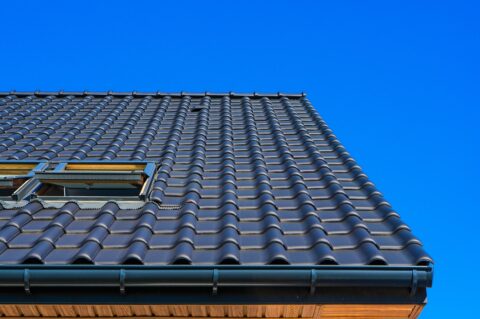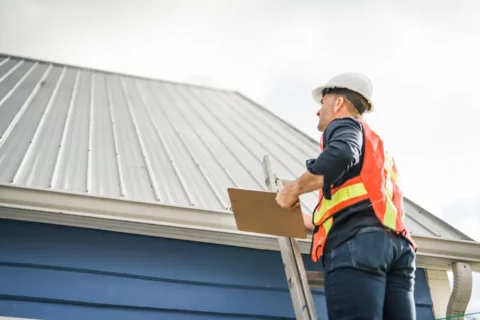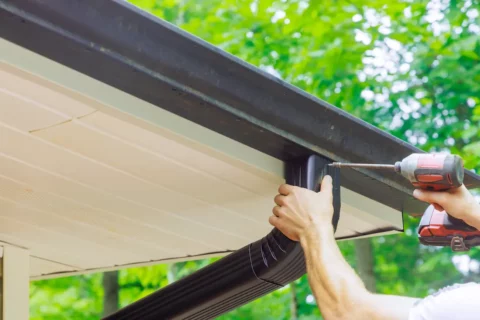At 303 Roofer, we understand the unique challenges that Denver homeowners face, particularly when it comes to weather-related roof damage. Hailstorms are a common occurrence in this region and can wreak havoc on your home’s roofing. In this blog, we’ll guide you through the essential steps to restore your Denver home after roof hail damage.
Identifying Roof Hail Damage
Hail damage to your roof can be sneaky; sometimes, it’s not immediately apparent. Identifying hail damage promptly is crucial to prevent more extensive issues down the road. In this section, we’ll delve deeper into how you can effectively identify roof hail damage.
Inspecting Your Roof
- Safety First: Before you begin, ensure your safety. Use a sturdy ladder, wear appropriate footwear, and take precautions to avoid slipping or falling. If you’re uncomfortable with heights or unsure, it’s always best to call professionals like 303 Roofer.
- Examine All Roofing Materials:** Start your inspection by examining all roofing materials, including shingles, flashing, gutters, vents, and even the siding of your home. Hail can cause damage to various surfaces.
- Check for Dents: Hail damage often leaves dents on the roof’s surface, especially on metal elements. These dents can weaken the integrity of your roof over time. Look for any irregularities or depressions on these surfaces.
- Inspect Shingles: If you have asphalt shingles, inspect them closely. Hail can dislodge the protective granules on the shingles, exposing the underlying material. This granule loss weakens the shingles and makes them more vulnerable to further damage.
- Look for Cracks: Wooden shingles may develop cracks or splits after a hailstorm. These cracks can allow water to penetrate, leading to leaks and further damage.
Signs of Hail Damage
- Granule Accumulation: After a hailstorm, you may find granules from asphalt shingles in your gutters or on the ground. This is a clear sign of hail damage, as the impact of the hailstones dislodges these granules.
- Circular Indentations: Small, circular indentations on soft metal surfaces like vents, gutters, and flashing are a surefire sign of hail damage. These dents are usually uniform in shape and often accompanied by chipped paint.
- Cracked or Split Shingles: Examine your asphalt or wooden shingles for any visible cracks or splits. Hail can cause these materials to weaken and deteriorate over time.
- Damaged Siding: Don’t forget to check your home’s siding for signs of hail damage. Look for dents, cracks, or chipped paint on the siding material.
- Water Stains or Leaks: If you notice water stains on your ceiling or walls inside your home, it could be a result of hail damage that has allowed moisture to infiltrate your roof.
Remember that hail damage may not always be apparent immediately after a storm. It can worsen over time due to exposure to the elements. If you suspect hail damage or aren’t confident in your assessment, it’s best to contact professionals like 303 Roofer for a thorough inspection. Timely identification and repair of hail damage can save you from costly repairs in the future and ensure the continued protection of your Denver home.
Immediate Steps After Hail Damage
Experiencing hail damage to your roof can be distressing, but taking immediate action can help mitigate further harm to your home. In this section, we’ll elaborate on the crucial steps you should take right after discovering hail damage.
Contacting Professionals
The first and most important step after hail damage is to contact a professional roofing company like 303 Roofer. Here’s why this is crucial:
- Expert Assessment: Trained professionals have the knowledge and experience to accurately assess the extent of the damage. What might appear as minor damage could have underlying issues that only experts can detect.
- Safety: Roof inspections can be dangerous, especially if you’re not equipped with the right tools and safety gear. Professionals are equipped to handle roof inspections safely.
- Preventing Further Damage: Immediate action is necessary to prevent further damage. Roofers can take temporary measures such as tarping or sealing damaged areas to prevent water infiltration and additional harm to your home’s interior.
Temporary Measures
While waiting for the professionals to arrive, you can take some temporary measures to minimize damage:
- Tarping: If you can safely access your roof, consider tarping damaged areas. This will help prevent rainwater from entering your home and causing interior damage.
- Document the Damage: Take photos or videos of the hail damage. This documentation can be useful for insurance claims.
- Clear Debris: Remove any debris or fallen branches from your roof and gutters. This will ensure that water can flow freely, reducing the risk of further issues.
Avoid DIY Repairs
It’s essential to resist the temptation to attempt DIY repairs, especially if you lack the necessary expertise. DIY fixes can often make the situation worse or void your roofing warranty. Leave the repairs to professionals who have the right tools and materials to do the job correctly.
Insurance Claims
If you have homeowner’s insurance, contact your insurance provider to initiate the claims process. Provide them with the documentation you’ve gathered, including photos and videos of the hail damage. Be prepared to answer questions and provide information as needed.
Safety Considerations
Keep safety in mind throughout the process. Walking on a damaged roof can be hazardous, and electrical lines may be affected as well. It’s best to leave the inspection and repair work to trained professionals who are equipped to handle these risks.
In summary, taking immediate action after hail damage is crucial to protect your Denver home. Contacting professionals like 303 Roofer, taking temporary measures to prevent further damage, and initiating the insurance claims process are essential steps in ensuring a swift and effective response to hail damage. Your safety and the integrity of your home are of paramount importance, and professional assistance is the best way to achieve both.
The Roof Hail Damage Repair Process
When your Denver home’s roof sustains hail damage, a comprehensive repair process is necessary to restore its integrity and protect your property. In this section, we will delve into the intricate details of the roof hail damage repair process, highlighting the steps involved in ensuring a thorough and effective restoration.
Comprehensive Inspection
The first step in the roof hail damage repair process is a comprehensive inspection carried out by skilled professionals from 303 Roofer. Here’s what this entails:
- Assessment of Damage: Our experts will meticulously assess all areas of your roof, identifying the extent of hail damage. This includes a close examination of the roofing material, flashing, gutters, vents, and any other relevant components.
- Documentation: Every instance of damage is documented to create a detailed report. This report serves as a foundation for planning the necessary repairs and replacements.
Repair and Replacement
Once the inspection is complete, our team proceeds with the necessary repairs and replacements. Here’s what this phase encompasses:
- Repairing Small Damage: For minor hail damage, our experts will carefully repair the affected areas. This may involve sealing small cracks, fixing dented flashing, or replacing individual damaged shingles.
- Replacement of Severely Damaged Components: In cases of extensive damage, entire sections or components of your roof may need replacement. This ensures the structural integrity of your roof is fully restored.
- High-Quality Materials: At 303 Roofer, we prioritize the use of high-quality roofing materials. This not only guarantees durability but also enhances the aesthetic appeal of your home.
Attention to Detail
During the repair and replacement process, our team pays meticulous attention to detail. This includes ensuring that all components are properly aligned and secured to prevent future issues. Proper sealing and flashing installation are essential to safeguard against leaks.
Weather Resistance
Denver’s climate can be challenging, with temperature fluctuations and precipitation. We take weather resistance into account during the repair process. Our aim is to provide roofing solutions that can withstand the elements and protect your home effectively.
Aesthetics
Your home’s curb appeal is important. We ensure that the repaired or replaced sections of your roof seamlessly blend with the existing roofing material to maintain the overall visual appeal of your property.
Final Inspection
Before considering the roof hail damage repair process complete, our professionals conduct a final inspection. This step ensures that all repairs and replacements have been executed to our high standards and that your roof is in optimal condition.
Post-Repair Cleanup
After the repairs are finished, our team ensures a thorough cleanup. This includes removing any debris or materials left from the repair process, leaving your property in a clean and tidy state.
Warranty and Peace of Mind
At 303 Roofer, we stand by the quality of our work. We provide warranties for our roofing services to give you peace of mind, knowing that your investment is protected.
In conclusion, the roof hail damage repair process is a meticulous and comprehensive undertaking that requires expertise and attention to detail. At 303 Roofer, we prioritize the restoration of your Denver home’s roofing integrity while also considering aesthetics, weather resistance, and your long-term satisfaction. Our goal is to leave you with a roof that not only functions flawlessly but also enhances the beauty and value of your property.
Hail damage can be a significant concern for Denver homeowners, but with 303 Roofer by your side, you can rest easy knowing that your home is in capable hands. Promptly addressing roof hail damage is essential to preserving the integrity of your home. Contact us today, and let us restore your Denver home to its former glory. Your peace of mind is our top priority.




